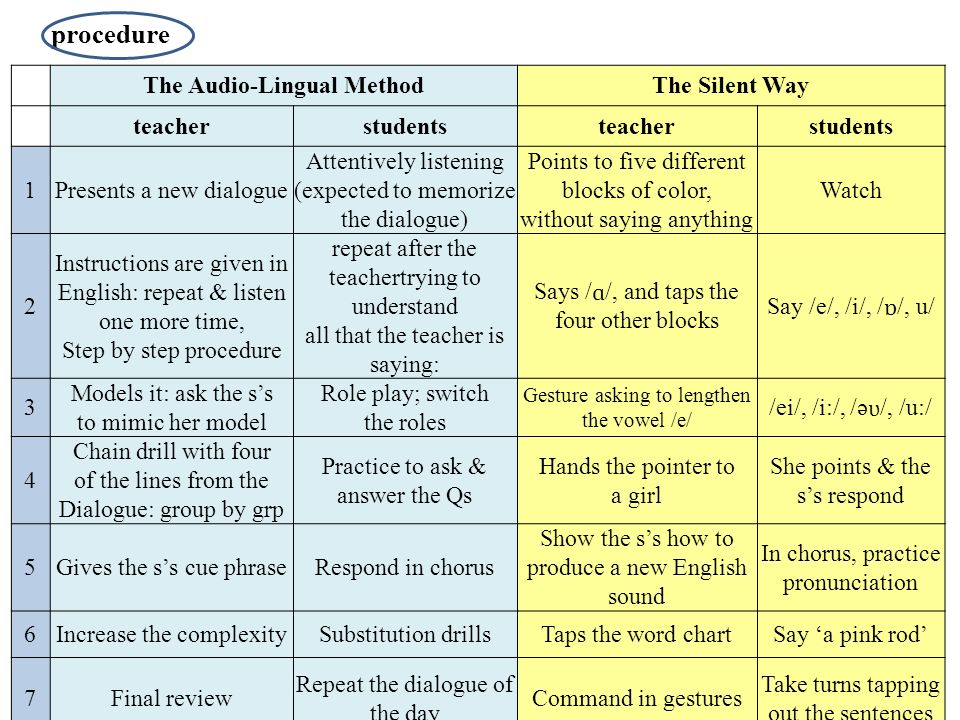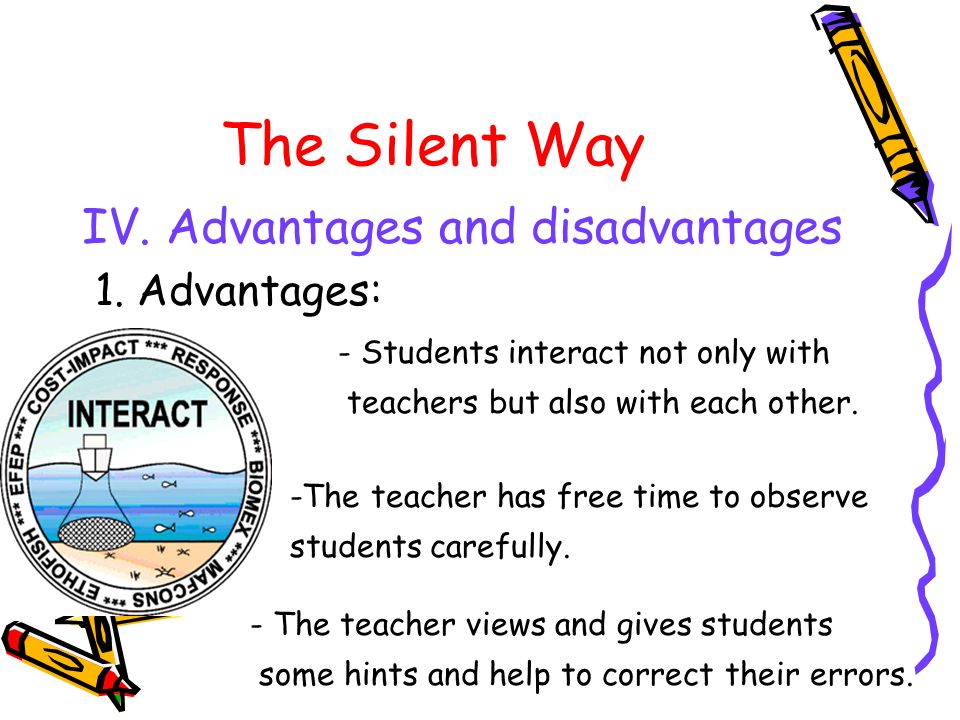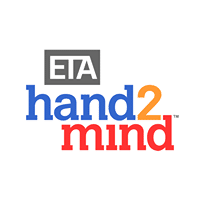Назар аударыңыз. Бұл материалды сайт қолданушысы жариялаған. Егер материал сіздің авторлық құқығыңызды бұзса, осында жазыңыз. Біз ең жылдам уақытта материалды сайттан өшіреміз
Жақын арада сайт әкімшілігі сізбен хабарласады

Бонусты жинап картаңызға (kaspi Gold, Halyk bank) шығарып аласыз
Түбір мен қосымша 2 сынып
Дипломдар мен сертификаттарды алып үлгеріңіз!


Материалдың толық нұсқасын
жүктеп алып көруге болады

 What is the Silent
Way?
What is the Silent
Way?
This unconventional method was developed alongside Afro hairstyles and platform shoes back in the 1970s by mathematician (yes, we said mathematician) Caleb Gattegno. It was based upon ideas outlined in his book “Teaching Foreign Languages in Schools the Silent Way,” published in 1963. Like most cultural events of the 60s and 70s, it was a reaction to previous approaches and methods that were considered excessively rigid and constricting.
The basic method that underlies this approach is simple but potentially quite powerful: In contrast to traditional methods, the emphasis is on the student’s learning rather than the teacher’s teaching. In fact, it is not uncommon for the teacher to remain silent for parts of a lesson.
In the absence of the teacher dominating the lesson, the student takes an active role in the learning process, and their input guides the learning trajectory. The teacher redirects and corrects when necessary, but the teacher grants students greater autonomy and fosters the development of independent problem-solving skills.
The role of the teacher is to direct students’ focus, facilitate self-reflection and provide verbal and nonverbal feedback when necessary. Students, on the other hand, are encouraged to speak as much as possible.
Most of the traditional tools for language instruction (textbooks, worksheets, verb conjugation tables) are completely absent from this method. In their place, instruction takes place through the medium of Cuisenaire rods (colored rods traditionally used in the teaching of math to primary school students) and charts that indicate the correct pronunciation of certain letters without the teacher having to teach pronunciation through rote memorization or call-and-response exercises.
Want to work from
home? Maintain flexible hours? Make a positive impact? Be part of
an empowering and collaborative
community?
Click here to join our
team!
Why might you decide to use the Silent Way method?
We know how you feel. Teaching a language with silence? How could that possibly work?
Don’t be too quick to judge. There are plenty of great reasons to at least give this method a try.
-
Student-directed learning. We all know what the research says: Students learn better when they can be active participants in their own learning. It just seems logical that, when it comes to language, allowing students to do all the talking is the best way to accomplish that.
-
Improved problem-solving skills. Without your input, students are forced to figure out all kinds of things on their own, mimicking some of the real-life problem-solving situations they might find themselves facing if immersed in the target language. These are skills that they will not have the opportunity to develop if the teacher always does the figuring out for them.
-
Increased engagement. Learning basic vocabulary and pronunciation can often feel monotonous to students. With the Silent Way, students are engaged in the learning process, discovering words and sounds instead of having these drilled into them. Students become more engaged and invested in the process as they assume more responsibility for their own learning, and tasks have more relevance.
-
A positive, safe learning environment. Limited input from the teacher means almost no criticism… which means students feel that it is safe to make mistakes, a necessary step in language learning.
-
It can supplement further student-centered work. Including the above features in your students’ learning will complement deeper interactive and independent work with the language. For example, they might do such work when using FluentU, a platform that offers students a unique and culturally authentic way to engage with real-world content at their own pace.
As you can probably imagine, though, the Silent Way is not without its drawbacks.
Potential problems with the Silent Way
The Silent Way is not for everyone. Here are some valid reasons for deciding not to use it.
-
It may feel strange and scary to some students. It is safe to say that your students have never experienced anything quite like the Silent Way before. Without adequate explanation or preparation, they might be unsure of how to handle it, especially in the beginning.
-
It may be challenging for some students. If a student has an IEP, or requires extra coaching or scaffolding due to special needs of any kind, they can really struggle with the Silent Way. These students need frequent interactions with their teacher in order to be successful.
-
Students may feel that they are not getting enough feedback. While traditional teaching methods make extensive use of verbal and written feedback, the Silent Way does not. This means that students will have to adjust to the new way of receiving feedback, and they may feel insecure about the lack of verbal positive or negative reinforcement in the beginning.
-
Progress may look different than with other methods. Advocates of the Silent Way will tell you that the focus is on learning a few things well rather than “covering” the material, but the Silent Way aims for quality rather than quantity. In other words, it may feel like students spend a lot of time learning the basics of vocabulary and pronunciation rather than progressing quickly through these topics, but remember that learning a language means developing many skills simultaneously. In fact, some skills such as accurate pronunciation may take years to master.
Strategies to make the Silent Way work for you and your students
If you do decide to use this method, here are some strategies to help you find success.
-
Educate students thoroughly from the outset about this method and why you are using it. Once you have achieved student buy-in, you can begin implementing this method without fear of scaring them away.
-
Check in individually with students who need it from time to time, to make sure that they are okay. You can schedule regular meeting times with them, or check in discreetly during class. This will help them feel more confident about their progress.
-
Give feedback non-verbally. Practice conveying a message with body language, gestures and facial expressions. You will be amazed at how much you can communicate to students without saying a word.
-
Emphasize quality rather than quantity. Clearly articulate that attaining mastery, rather than simply covering everything in the curriculum, is the priority.
Now that you understand the basics of the Silent Way and how it works, let’s begin to put it into practice with an actual activity.
A Silent Way-inspired sample activity
There is a wealth of literature on the techniques and methods of the Silent Way. If you want to become an expert, we recommend starting with Gattegno’s original book, Teaching Foreign Languages in Schools the Silent Way (which is available for free online) and then working your way up from there.
However, even if you don’t become formally trained as an expert in the Silent Way, you can still utilize some Silent Way methodologies in your language classroom.
First, you’ll need the right equipment:
 You can
find Cuisenaire
rods at most educational
supply stores that sell classroom manipulatives. One great online
resource is Hand2Mind, a site where you can easily
find and order a wide variety of classroom resources. You can look
for whatever you need under “Grade” or a category like “Math,”
“Science” or “Literacy” (in this case, you could go to “Math” and
scroll down to “Manipulatives”) or simply use the search field.
There are over 40 options for Cuisenaire rods alone that you can
browse through and choose from based on factors like class
size.
You can
find Cuisenaire
rods at most educational
supply stores that sell classroom manipulatives. One great online
resource is Hand2Mind, a site where you can easily
find and order a wide variety of classroom resources. You can look
for whatever you need under “Grade” or a category like “Math,”
“Science” or “Literacy” (in this case, you could go to “Math” and
scroll down to “Manipulatives”) or simply use the search field.
There are over 40 options for Cuisenaire rods alone that you can
browse through and choose from based on factors like class
size.
Silent Way charts are a bit more difficult to find. A website called Educational Solutions is the sole supplier of them. But it is also completely feasible to look at examples of them and create your own. Examples of English pronunciation charts can be found here. Links to pronunciation charts in other languages, such as Chinese, Japanese and French, can be reached via the website of Donald Cherry, a long-time practitioner and advocate of the Silent Way. You can also find other resources on TED Ed to help you get set up for using this method in your classroom.
You will begin by instructing your students on pronunciation using a chart with multicolored rectangles. What do rectangles have to do with pronunciation, you ask? Well, each color represents a different sound. Once the students have learned, through repetition, what these sounds are, you can move on to charts that have short words, with letters that are color-coded to represent the sounds. (See, for example, these charts from Pronunciation Science.)
Once students have connected the colors to the sounds, you can teach the pronunciation of simple words without almost no verbal intervention at all. It is just a matter of pointing to the correct sound on the chart and indicating to the student, through your body language, whether they are pronouncing it correctly or not. At this point, you’ll also want to solicit feedback among students, which is an important part of Silent Way teaching. You can tap one sound harder than the others if you need to show students which syllable of a word to stress.
Once students have learned which sound corresponds to which color, you can walk them through a simple activity.
-
Call a student to the front of the room and hand them a rod. Using the pronunciation chart, point out the sounds to help students form the words: “Put the rod on the table.”
-
Ask the class (through gesture) to repeat the instruction: “Put the rod on the table.”
-
The student then follows the direction and puts the rod on the table.
-
Next point out another direction using the chart: “Put the rod under the table.”
-
Follow the same process outlined in Steps 2-3.
-
Continue by asking students to direct each other to put rods in different places (“on the chair,” “in front of the window,” etc.)
The wonderful thing about this activity is that it gets students talking and problem-solving together in the target language… with virtually no verbal intervention from you.
Practical considerations for everyday use of the Silent Way
As you can tell, there are certainly advantages to this unconventional method. After all, every teacher’s ultimate goal is to equip their students with the tools to manage the content independently, with limited teacher intervention.
But is the Silent Way really practical? How much will your students learn?
The answer depends on you and your students. Some teachers use the Silent Way religiously. They and their students will tell you that they have found it far superior to any other method.
At the other extreme, some will tell you it is nonsense.
As with most things in education and in life, a balanced approach is key.
Especially when you first begin using it, it may be preferable to combine aspects of the Silent Way with some of the best practices taken from other methods.
In fact, if you examine the Silent Way closely, it does bear some resemblance to other more popular methods. Like TPR, it gets students moving, speaking and constructing meaning independently without textbooks and drills. Like with task-based language learning, the focus is taken away from learning language for its own sake, and instead becomes all about functionality and accomplishing a task together.
In short, the Silent Way perhaps has more advantages than we have given it credit for, and deserves (at the very least!) a second look.

